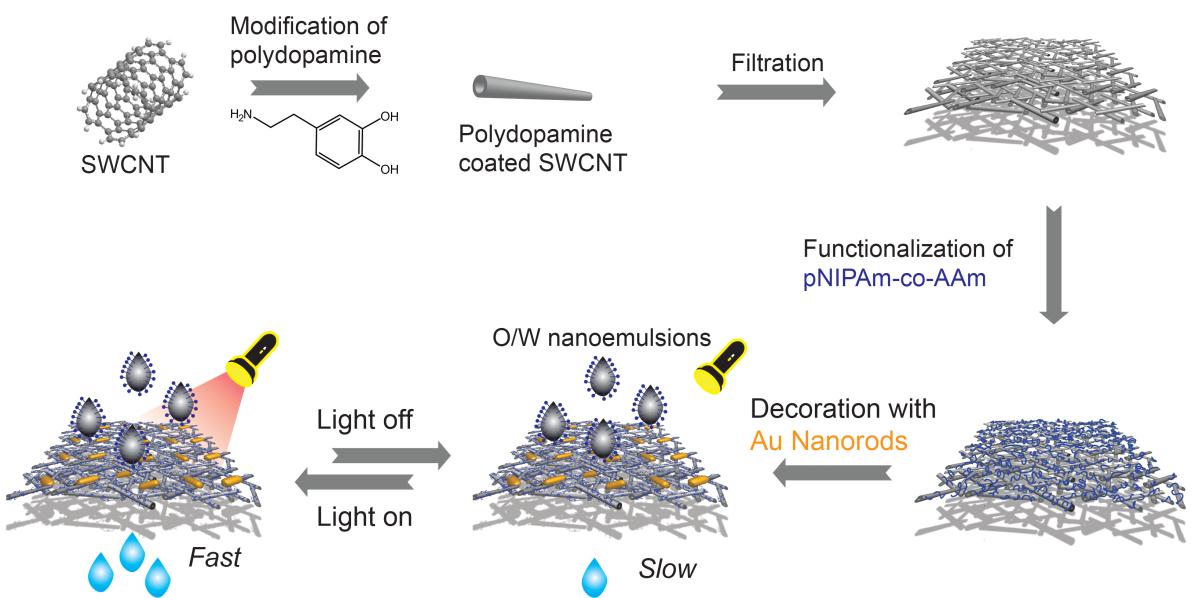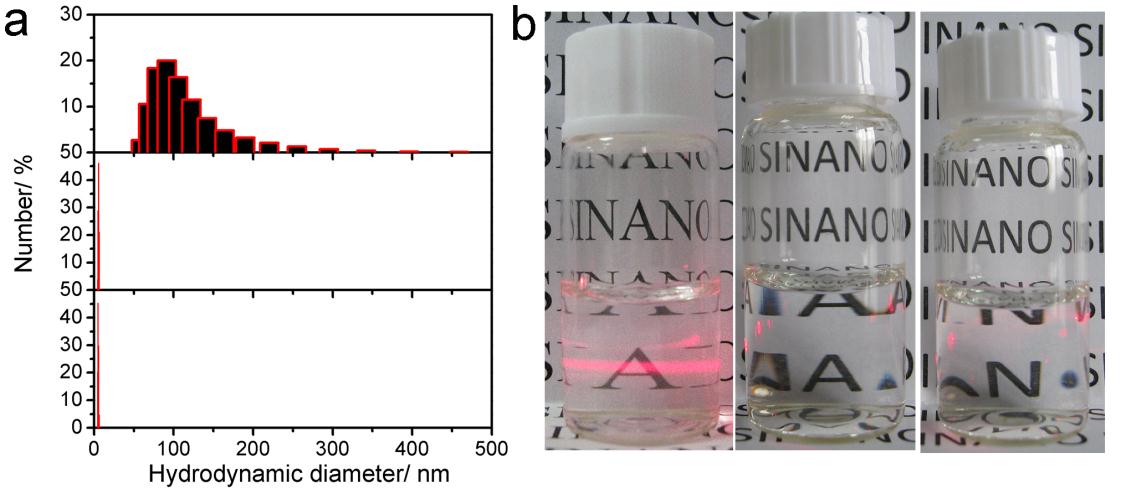Oil-contaminated wastewater threatens our environment and health, especially that stabilized by surfactants. Conventional separation protocols become invalid for those surfactant stabilized nanoemulsions due to their nanometer-sized droplets and extremely high stability. To solve these obstacles, a myriad of membranes with special wettability has been explored to dispose oil/water mixtures. However, few of them are valid for oil-in-water (O/W) nanoemulsions.
Recently, Dr. JIN Jian’s group from Suzhou Institute of Nano-tech and Nano-bionics, Chinese Academy of Sciences (SINANO), has reported a novel approach to construct Au nanorods (ANRs)/ poly(N-isopropylacryamide-co-acrylamide) (pNIPAm-co-AAm) co-hybrid ultrathin single-walled carbon nanotubes (SWCNT) network membranes with light-modulated pore sizes for on/off switchable ultrafast separation of O/W nanoemulsions.( ACS Nano, 2015, 9, 4835–4842.)
Herein, the incorporation of pNIPAm-co-AAm endows the ultrathin SWCNT network film with a hydrophilic surface and potential antifouling property, which are beneficial for ultrafast separation of O/W nanoemulsions. Notably, pNIPAm-based copolymers render the membrane a chemical valve function through reversibly varying polymers’ conformation triggered by heat and thus resulting in a tunable pore radius and correspondingly on/off switchable permeation property. As membrane separation is a non-stop ongoing procedure, achieving thermoresponse through direct change in the temperature of oil/water mixture is unaccessible and thus difficult to be implemented in realistic applications. Alternatively, photothermal responsive nanoporous membranes enable the realization of uninterruptedly and remotely controlling the pore sizes via coupled ANRs in this publication.
In brief, our photothermo-responsive nanoporous membranes were constructed by four steps (Figure 1), involving (1) modification of SWCNT with dopamine, (2) fabrication and decoration of polydopamine-coated SWCNT membrane with (3) pNIPAm-co-AAm and, subsequently, (4) excess ANRs. This is the first sample of photothermo-responsive SWCNT-based ultrathin membranes for on/off-switchable, or control flow, separation of O/W nanoemulsions. While ultrahigh separation efficiency, desired antifouling and recyclability properties were achieved.
In this bulletin, treating n-hexadecane-in-water dodecyl sulfate sodium-stabilized (H/W) nanoemulsion was selected as an example. Initially, H/W nanoemulsion appears semitransparent with a droplet size of 60 - 460 nm, exhibiting an apparent Tyndall phenomenon (Figure 2). Once H/W was filtrated through the membrane, a transparent liquid in filtrate with a drop size of less than 5 nm was collected. This can be explained by the fact that when H/W emulsion droplet contacts with the membrane, n-hexadecane is essentially rejected due to the underwater oleophobicity. Combined with the nanometer-sized pore radii, permeation of H/W micelles towards membrane is hindered. Interestingly, when the temperature of the membrane was heated above the lower critical solution temperature of pNIPAm-co-AAm after exposure, H/W can be effectively separated under such condition as well (Figure 2). This indicates the increased effective pore size is still far less than the minimum size of the emulsion droplets. Accordingly, the permeation flux (J) increases from 3670 to 9000 L•m2•h-1•bar-1. Total organic carbon analysis clearly shows that the oil concentrations in filtrate in both cases are less than 5 ppm. Possibly most importantly, our ultrathin photothermo-responsive SWCNT-based membranes evoke a potential in the generation of point-of-use water treatment devices in developing areas.
We acknowledge the support from the National Basic Research Program of China (2013CB933000), the National Natural Science Foundation of China (21433012, 51403231, 21473239), the Key Development Project of Chinese Academy of Sciences (KJZD-EW-M01-3), the Natural Science Foundation of Jiangsu Province (BK20130007) and the Jiangsu Planned Projects for Postdoctoral Research Funds (1401067C).

Figure 1. Schematic illustration for the fabrication of photothermo-responsive Au nanorods/ pNIPAm-co-AAm co-hybrid SWCNT ultrathin membranes.(Image by JIN Jian's Group)

Figure 2. (a) Dynamic light scattering data and (b) the corresponding photographs for (up in a, left in b) pristine H/W, filtrate separated under light switched (middle in a and b) off and (bottom in a, right in b) on.(Image by JIN Jian's Group)
(Information Source: Suzhou Institute of Nano-Tech and Nano-Bionics, CAS)

